Actual expenditures
Departmental spending trend graph
The following graph presents planned (voted and statutory spending) over time.
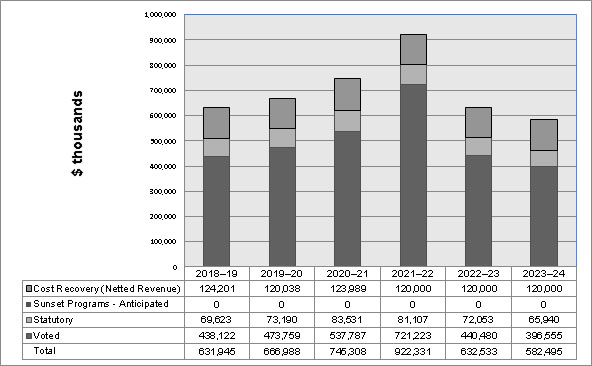
Description - Departmental spending trend graph
| Fiscal year | Total | Voted | Statutory | Sunset Programs - Anticipated | Cost Recovery (Netted Revenue) |
|---|---|---|---|---|---|
| 2018–19 | 631,945 | 438,122 | 69,623 | 0 | 124,201 |
| 2019–20 | 666,988 | 473,759 | 73,190 | 0 | 120,038 |
| 2020–21 | 745,308 | 537,787 | 83,531 | 0 | 123,989 |
| 2021–22 | 922,331 | 721,223 | 81,107 | 0 | 120,000 |
| 2022–23 | 632,533 | 440,480 | 72,053 | 0 | 120,000 |
| 2023–24 | 582,495 | 396,555 | 65,940 | 0 | 120,000 |
| Core Responsibilities and Internal Services | 2020–21 Main Estimates | 2020–21 Planned spending | 2021–22 Planned spending | 2022–23 Planned spending | 2020–21 Total authorities available for use | 2018–19 Actual spending (authorities used) | 2019–20 Actual spending (authorities used) | 2020–21 Actual spending (authorities used) |
|---|---|---|---|---|---|---|---|---|
| Statistical Information | 661,506,812 | 661,506,812 | 855,425,655 | 566,602,643 | 715,298,954 | 559,559,344 | 584,770,894 | 666,463,788 |
| Internal Services | 73,941,885 | 73,941,885 | 66,905,037 | 65,930,587 | 80,666,297 | 72,385,465 | 82,217,225 | 78,844,148 |
| Total gross expenditures | 735,448,697 | 735,448,697 | 922,330,692 | 632,533,230 | 795,965,251 | 631,944,809 | 666,988,119 | 745,307,936 |
| Respendable Revenue | -120,000,000 | -120,000,000 | -120,000,000 | -120,000,000 | -123,989,068 | -124,200,719 | -120,038,495 | -123,989,068 |
| Total Net Expenditures | 615,448,697 | 615,448,697 | 802,330,692 | 512,533,230 | 671,976,183 | 507,744,090 | 546,949,624 | 621,318,868 |
Statistics Canada is funded by two sources: direct parliamentary appropriations and cost-recovery activities. Statistics Canada has the authority to generate $120 million annually in respendable revenue related to two streams: statistical surveys and related services, and custom requests and workshops. If exceeded, a request can be made to increase the authority, as was the case in the last few years.
In recent years, respendable cost-recovery revenue has contributed between $120 million and $124 million annually to the agency’s total resources. A large portion of this respendable revenue comes from federal departments to fund specific statistical projects.
Spending fluctuations between the years shown in the graph and table above were mainly caused by the Census Program. Voted spending decreased in 2018–19 as the 2016 Census of Population and 2016 Census of Agriculture were winding down. This pattern is typical for the agency because of the cyclical nature of the Census Program. Spending then begins to ramp up and peak again in 2021–22 when the 2021 Census of Population and 2021 Census of Agriculture are conducted, followed by a significant decrease in subsequent years as these activities wind down.
The difference between 2020–21 actual spending and 2020–21 total authorities available for use is largely attributable to how the agency strategically manages its investments. The agency has leveraged the operating budget carry-forward mechanism to manage the cyclical nature of normal program operations towards the agency’s strategic priorities and to ensure the quality of its existing programs is maintained. Throughout the year, forecast lapses and amounts carried forward are managed centrally, by priority, within the statistical information core responsibility.
The difference is also attributable to several amendments to the 2021 Census of Population’s original spending plan, resulting in a decrease in spending for 2020–21. These amendments are mostly because of the COVID-19 pandemic.
Internal Services’ spending from 2018–19 to 2020–21 includes planned resources from temporary funding related to an initiative approved in 2018–19 to migrate the agency’s infrastructure to the cloud.
| Core responsibilities and Internal Services | 2020–21 Actual gross spending | 2020–21 Actual revenues netted against expenditures | 2020–21 Actual net spending (authorities used) |
|---|---|---|---|
| Statistical Information | 666,463,788 | -123,989,068 | 542,474,720 |
| Internal Services | 78,844,148 | 0 | 78,844,148 |
| Total Gross Expenditures | 745,307,936 | -123,989,068 | 621,318,868 |
Statistics Canada has generated $124 million in respendable revenue from the sale of statistical products and services.
Actual human resources
| Core responsibilities and Internal Services | 2018–19 Actual full-time equivalents | 2019–20 Actual full-time equivalents | 2020–21 Planned full-time equivalents | 2020–21 Actual full-time equivalents | 2021–22 Planned full-time equivalents | 2022–23 Planned full-time equivalents |
|---|---|---|---|---|---|---|
| Statistical Information | 5,498 | 5,595 | 5,800 | 6,099 | 6,026 | 5,065 |
| Internal Services | 645 | 626 | 585 | 684 | 563 | 546 |
| Total Gross Expenditures | 6,143 | 6,221 | 6,385 | 6,783 | 6,589 | 5,611 |
| Respendable Revenue | -1,380 | -1,366 | -1,251 | -1,340 | -1,231 | -1,241 |
| Total Net Expenditures | 4,763 | 4,856 | 5,134 | 5,443 | 5,358 | 4,370 |
Similar to trends seen in planned spending, full-time equivalent (FTE) changes from year to year are largely explained by the cyclical nature of the Census Program. Activity decreased in 2018–19, as the 2016 Census of Population and 2016 Census of Agriculture were winding down. Activity then begins to ramp up and peak again in 2021–22, when the 2021 Census of Population and 2021 Census of Agriculture are conducted. There is also a temporary FTE increase in 2020–21 explained by Statistics Canada’s survey interviewers hired under the Statistics Act, to provide additional capacity for provincial and territorial governments to conduct contact tracing.
Included in net expenditure FTEs are approximately 410 public servant FTEs based across Canada outside the National Capital Region (NCR). Also included are approximately 1,095 interviewer FTEs (representing approximately 2,100 interviewers) outside the NCR. These interviewers are part-time workers with assigned workweeks that are determined by the volume of collection work available; they are hired under the Statistics Act, by the authority of the Minister of Innovation, Science and Industry. Interviewers are covered by two separate collective agreements and are employed through Statistical Survey Operations. Many of Statistics Canada’s main outputs rely heavily on data collection and the administration of these activities, which takes place across Canada.
Expenditures by vote
For information on Statistics Canada’s organizational voted and statutory expenditures, consult the Public Accounts of Canada 2020–2021.
Government of Canada spending and activities
Information on the alignment of Statistics Canada’s spending with the Government of Canada’s spending and activities is available in GC InfoBase.
Financial statements and financial statements highlights
Financial statements
Statistics Canada's financial statements (unaudited) for the year ending March 31, 2021, are available on the agency's website.
The agency uses the full accrual accounting method to prepare and present its annual financial statements, which are part of the departmental results reporting process. However, spending authorities presented in the previous sections of this report remain on an expenditure basis. A reconciliation between the bases of reporting is available in Note 3 of the financial statements.
Financial statement highlights
| Financial information | 2020–21 Planned results | 2020–21 Actual results | 2019–20 Actual results (restated) | Difference (2020–21 Actual results minus 2020–21 Planned results) | Difference (2020–21 Actual results minus 2019–20 Actual results) |
|---|---|---|---|---|---|
| Total expenses | 848,569,377 | 852,413,139 | 757,438,321 | 3,843,762 | 94,974,818 |
| Total revenues | 120,000,000 | 120,247,616 | 121,936,643 | 247,616 | -1,689,027 |
| Net cost of operations before government funding and transfers | 728,569,377 | 732,165,523 | 635,501,678 | 3,596,146 | 96,663,845 |
Statistics Canada's Future-Oriented Statement of Operations (unaudited) for the year ending March 31, 2021, is available on the agency website. The assumptions underlying the forecasts were made before the completion of the 2019–20 fiscal year.
The net cost of operations before government funding and transfers was $732.2 million, an increase of $96.7 million (15.2%) from $635.5 million in 2019–20. The increase in expenses is mainly because of an overall increase in the agency’s activities, particularly for the 2021 Census of Population Program, the workload migration and cloud program, and the COVID-19 initiatives in partnership with Health Canada. Additionally, salary costs increased because of the ratification of certain collective agreements in 2020–21. This is offset by an immaterial decrease in revenue related to cost-recovery projects mainly with non-federal clients.
The difference between actual and planned net costs for 2020–21 is $3.6 million (0.5%). Expenses were $3.8 million higher than anticipated. The ratification of collective agreements, as well as higher vacation pay and compensatory leave accrual, and additional spending for COVID-19 initiatives in partnership with Health Canada contributed to a significant increase in expenditures. This is mostly offset by a change in the 2021 Census of Population Program spending profile because of the COVID-19 pandemic and other factors, which resulted in a decrease in non-salary spending. Revenues were $0.2 million higher than anticipated.
For more information on the distribution of expenses by program and type, please see the two charts below.
Gross expenditures by core responsibility
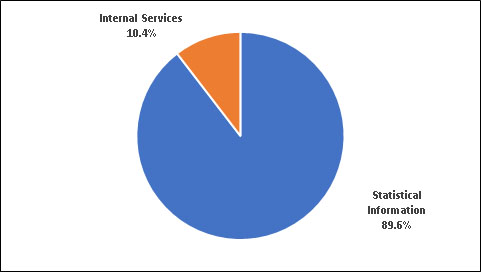
Total expenses, including respendable revenue and services provided without charge by federal government departments, were $852.4 million in 2020–21. These expenses comprised $763.4 million (89.6%) for Statistical Information and $89 million (10.4%) for Internal Services.
Gross expenditures by type
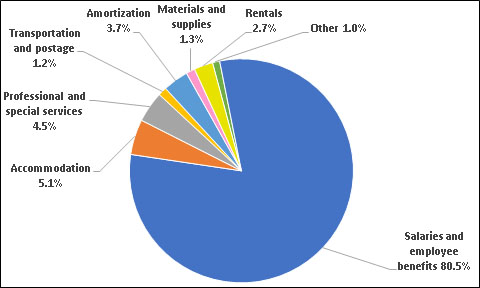
Statistics Canada spent $852.4 million in 2020–21. These expenses comprised $685.9 million (80.5%) for salaries and employee benefits, $43.6 million (5.1%) for accommodation, $38.0 million (4.5%) for professional and special services, $31.5 million (3.7%) for amortization, $23.1 million (2.7%) for rentals, $10.8 million (1.3%) for materials and supplies, $10.6 million (1.2%) for transportation and postage, and $8.5 million (1.0%) in other expenses.
| Financial information | 2020–21 | 2019–20 (restated) | Difference (2020–21 minus 2019–20) |
|---|---|---|---|
| Total net liabilities | 160,919,348 | 130,839,608 | 30,079,740 |
| Total net financial assets | 77,141,756 | 66,957,087 | 10,184,669 |
| Departmental net debt | 83,777,592 | 63,882,521 | 19,895,071 |
| Total non-financial assets | 170,230,625 | 170,649,354 | -418,729 |
| Departmental net financial position | 86,453,033 | 106,766,833 | -20,313,800 |
The departmental net financial position was $86.5 million at the end of 2020–21, a decrease of $20.3 million from $106.8 million in 2019–20.
The increase in total net liabilities is mainly explained by an increase in accrued liabilities for vacation pay and compensatory leave resulting from employees accumulating vacation days during the COVID-19 pandemic and an increase in accounts payable, mostly for the 2021 Census of Population Program.
The increase in total net financial assets is mainly explained by an increase in the amount due from the Consolidated Revenue Fund as of March 31 to pay for accounts payable and accrued salaries and wages. This is offset by a decrease in accounts receivable from other government departments and agencies and external parties.
For more information on the distribution of the balances in the statements of financial position, please see the two charts below.
Assets by type
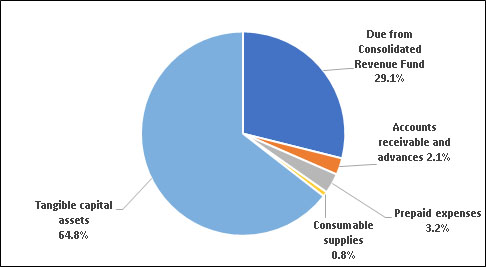
Total assets, including financial and non-financial assets, were $247.4 million at the end of 2020–21. Tangible capital assets represented the largest portion of assets, at $160.4 million (64.8%). They consisted of informatics software ($77.0 million), software under development ($66.9 million), leasehold improvements ($14.6 million) and other assets ($1.9 million). The remaining portion comprised $71.9 million (29.1%) for amounts due from the Consolidated Revenue Fund, $7.9 million (3.2%) for prepaid expenses, $5.3 million (2.1%) for accounts receivable and advances, and $1.9 million (0.8%) for consumable supplies.
Liabilities by type
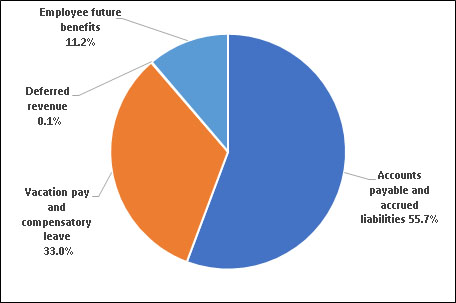
Total liabilities were $160.9 million at the end of 2020–21. Accounts payable and accrued liabilities made up the largest portion of liabilities, at $89.6 million (55.7%). They consisted of accounts payable to external parties ($41.7 million), accounts payable to other federal government departments and agencies ($11.6 million), and accrued salaries and wages ($36.3 million). The next largest portion was vacation pay and compensatory leave, at $53.1 million (33.0%). Employee future benefits made up $18.1 million (11.2%). The remaining portion was composed of deferred revenue, at $0.1 million (0.1%).